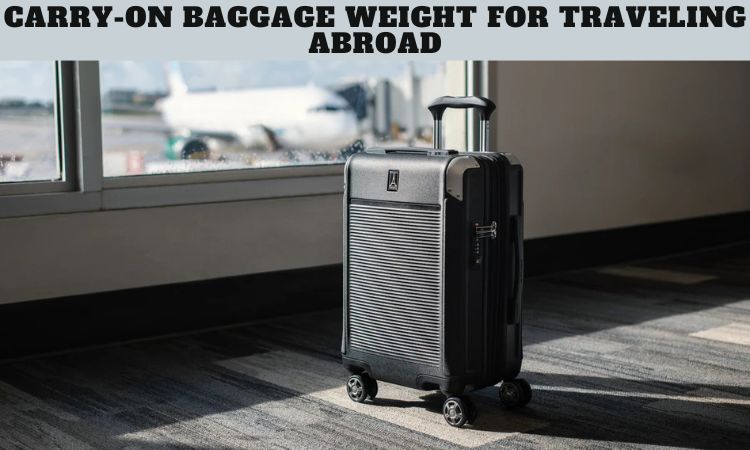Carry-On Baggage Weight for Traveling Abroad

Traveling abroad is an exciting experience, but understanding carry-on baggage weight for traveling abroad can make or break your journey. Airlines around the world have specific rules and restrictions when it comes to carry-on luggage. This guide provides a comprehensive overview of carry-on baggage weight limits, policies, and tips to help you travel smoothly and confidently.
Understanding Carry-On Baggage Weight Policies
Airline regulations for carry-on baggage weight vary depending on the carrier, route, and travel class. While most airlines allow passengers to bring one piece of carry-on luggage and a personal item, weight limits are often strictly enforced.
Standard Weight Limits for Carry-On Baggage
- Domestic Flights: Most airlines allow a carry-on weight limit between 7 kg (15 lbs) and 10 kg (22 lbs).
- International Flights: On international routes, the weight limit is typically around 7 kg to 12 kg (15 lbs to 26 lbs).
- Low-Cost Airlines: Budget airlines often have stricter weight limits, sometimes as low as 5 kg (11 lbs). Additional charges may apply for exceeding this limit.
Class-Specific Weight Allowances
Passengers flying in premium cabins, such as business class or first class, often enjoy higher carry-on weight limits. Some airlines allow up to 15 kg (33 lbs) for these passengers.
Factors Influencing Carry-On Weight Limits
Airline Policies
Each airline has its unique guidelines, which can often be found on their official website. Carry-on baggage weight for traveling abroad differs widely among full-service carriers, budget airlines, and charter flights.
Aircraft Type
Smaller aircraft, such as regional jets or turboprops, may have stricter size and weight limitations due to limited overhead storage.
Route Regulations
Certain international destinations, particularly in regions like Asia and Europe, have more stringent weight and size rules.
Top Airline-Specific Carry-On Weight Limits
American Airlines
- Weight Limit: No specified weight limit.
- Size Restriction: 22 x 14 x 9 inches (56 x 36 x 23 cm).
Emirates
- Economy Class: 7 kg (15 lbs).
- Business/First Class: 7 kg (15 lbs) + additional personal item allowance.
Ryanair
- Weight Limit: 10 kg (22 lbs) for priority boarding passengers.
- Non-Priority: Only a small personal item allowed.
Singapore Airlines
- Economy Class: 7 kg (15 lbs).
- Premium Economy/Business Class: 7 kg + additional 7 kg for personal items.
Packing Tips for Staying Within Carry-On Weight Limits
Packing light can be challenging, especially when adhering to strict carry-on baggage weight for traveling abroad. Here are practical tips to avoid overweight fees and streamline your travel:
Choose Lightweight Luggage
Invest in a lightweight carry-on bag that maximizes capacity without adding unnecessary weight. Look for durable materials like polycarbonate or high-denier nylon.
Weigh Your Bag at Home
Use a portable luggage scale to ensure your carry-on complies with the airline’s weight limits. Check the weight after packing and make adjustments as needed.
Roll Your Clothes
Rolling clothes instead of folding them saves space and prevents wrinkles. Use compression packing cubes to organize your items efficiently.
Wear Bulky Items
To save space in your bag, wear heavier items like jackets, boots, and jeans on the plane. This strategy minimizes carry-on weight while keeping you warm during the flight.
Limit Liquids
Liquids in your carry-on must comply with the TSA 3-1-1 rule: containers must be 3.4 ounces (100 ml) or smaller and fit into a single quart-sized bag. Reducing liquid items can free up significant weight.
Common Challenges with Carry-On Baggage Weight
Overweight Baggage Fees
Exceeding the carry-on weight limit can result in additional charges, often costing more than checking a bag.
Inconsistent Enforcement
While some airlines strictly enforce weight limits at check-in or the boarding gate, others may be more lenient. It’s essential to be prepared regardless of enforcement.
Limited Overhead Bin Space
On full flights, finding space in the overhead bin can be challenging, especially if your bag is larger or heavier than permitted.
Benefits of Adhering to Carry-On Weight Limits
Traveling with a compliant carry-on bag has multiple advantages:
- Faster Boarding and Deplaning: Avoid waiting at baggage claim by carrying your essentials with you.
- Cost Savings: Eliminating checked baggage fees can save you significant money.
- Reduced Risk of Lost Luggage: Keep valuable and essential items close at hand.
- Travel Flexibility: Move seamlessly between connecting flights without the hassle of checked bags.
FAQs About Carry-On Baggage Weight for Traveling Abroad
What happens if my carry-on exceeds the weight limit?
Airlines may require you to check the bag, often incurring additional fees. Be sure to check your airline’s policy in advance.
Can I carry food or souvenirs in my carry-on?
Yes, but ensure the total weight remains within the airline’s limits. Be aware of customs restrictions for certain items.
Are personal items included in the weight allowance?
Some airlines count personal items, like backpacks or handbags, toward the total carry-on weight, while others do not. Always confirm this detail beforehand.
Conclusion
Understanding carry-on baggage weight for traveling abroad is crucial for a hassle-free travel experience. By familiarizing yourself with airline-specific policies, planning your packing strategy, and adhering to weight limits, you can avoid unnecessary fees and complications. Travel smarter and lighter to make the most of your international adventures.